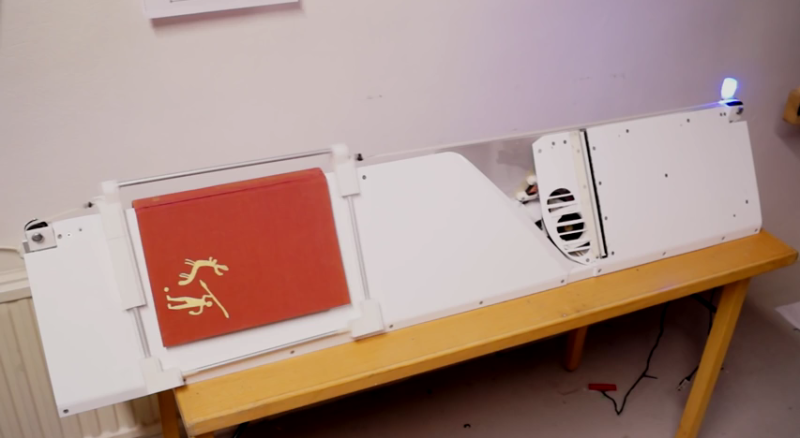About two and half years ago, the Google Books team open-sourced the plans for their book scanning rig, and there was much rejoicing. As [Dany Qumsiyeh] explained in the Google Tech talk we linked to at the time, the scanner uses a vacuum to lift the next page from the stack and turn it, saving hours of human labor and, admittedly, putting books in a little bit of danger.
[Chris] tipped us off about a different take on the linear book scanner created by [Forssa1] that uses server fan to turn the pages. [Forssa1]’s rig is built from laser-cut acrylic and employs two handheld scanners driven by an Arduino Mega. We don’t have a great deal of information about this build, but you can check it out after the break.
UPDATE: [Forssa1] checked in with us and sent a link to more build photos of his book scanner.
Thanks for the tip, [Chris]!
















How is it ensured, that only one page turned at a time.
it probably doesn’t but if you use ocr to recognise the page number you can bleep or display a message about the pages that are missing
That appears to be up to the stiffness of each piece of paper.
Also note that this design requires books to be of a certain size in order to work.
Yep, looks like those small $5 books like romance novel or sci-fi would be hard to scan because of short pages and thick, tight spine. Perfect for larger books though.
I don’t think it does, as always make sure to check your work. It seems to me it could also rip pages if your unlucky.
About 45% of the books tested had at least one rip or a folded page.
The suction generated sucks only on
The innermost page
Brief transition leaves pages behind
I hope that you weren’t attempting a haiku.
Here’s a take on the book scanner that’s actively being developed by a group of makers in Germany: https://www.youtube.com/watch?v=1Zl4ribN0IM
They are using the coanda effector technique to turn the pages.
Was a great success at Maker Faire Hannover (that’s actually where the team first met two years ago).
If you read German, there’s a longform article in the previous issue of (German) Make: http://www.heise.de/make/inhalt/2015/1/90/
“a server fan”, or “server fans”?
The pedantry is strong in this one.
Without pedants, there would be no science. Idiot.
I’ve noticed that there are a lot of pedantphiles around here.
I’d be scared to use that on a good book. It looks like a good way to rip out one page at a time.
It looks like one of those big deli meat slicers in operation.
It would be faster, cheaper, and more reliable to use one of Apple’s sweatshops in China to do this manually. If one of your scanners breaks, you simply hire their children.
^+1. Not much fun beating a plastic scanner for pausing.
Beats shooting your computer.
Check the news, it happened the other day. Police responded to the shots in an alley.
Lololo it’s so fun to joke about the horrible working conditions of some Chinese factory workers, but God forbid you poke fun at the rape of a woman. Hypocrites.
Society.
I think such labor is now done in the US by US prisoners, but they get paid though, one dollar a week I think it was.
Call your broker for investment opportunities.
Please have a look onto our Scanning project (also based onto Dany) – http://www.bookscanner.gg
first model and project history: https://youtu.be/huziNyhxeqk
and second model: https://www.youtube.com/watch?v=I8f17RfESnQ
We are using pressured air instead vacuum.
for non-rare books i think i would opt for destructive scanning. cut the spines off with a guillotine and plop the innards into an automated office scanner.
books that are rare or fragile would probibly be better off having their pages turned by hand, being photographed with both high resolution and depth cameras. then algorithmically flatten out and re-render the page as an image file. ocr to preserve the content, and keep the scans on file for historical reasons.
No need for depth cameras, you can just use a single camera with structured light (google has a patent on that BTW).
The best thing about hand scanning is the ability to insert a black page behind the one being scanned to eliminate back-scatter from showing the reverse side ghost image. When I scanned a book this way it eliminated at least 90% of the difficult to clean noise in the image. The remainder was actual dirt and other marks.
+1
Black backing worked well when I scanned an oil soaked rare old shop manual with translucent pages. Then white-balance post processing to make brown pages white again.
My sister was once bitten by a moose.